SDN第七次上机实验
实验7:基于REST API的SDN北向应用实践
一、实验目的
- 能够编写程序调用OpenDaylight REST API实现特定网络功能;
- 能够编写程序调用Ryu REST API实现特定网络功能。
二、实验环境
- 下载虚拟机软件Oracle VisualBox或VMware;
- 在虚拟机中安装Ubuntu 20.04 Desktop amd64,并完整安装Mininet、OpenDaylight(Carbon版本)、Postman和Ryu;
三、实验要求
(一)基本要求
-
OpenDaylight
(1) 利用Mininet平台搭建下图所示网络拓扑,并连接OpenDaylight;

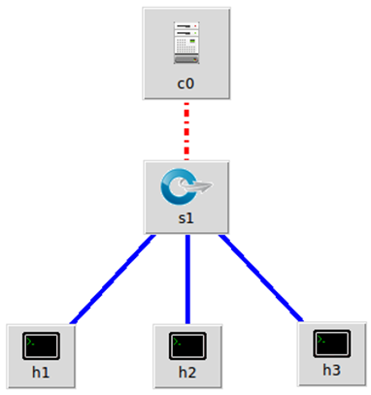
(2) 编写Python程序,调用OpenDaylight的北向接口下发指令删除s1上的流表数据。
#!/usr/bin/python
import requests
from requests.auth import HTTPBasicAuth
def http_delete(url):
url= url
headers = {'Content-Type':'application/json'}
resp = requests.delete(url,headers=headers,auth=HTTPBasicAuth('admin', 'admin'))
return resp
if __name__ == "__main__":
url='http://127.0.0.1:8181/restconf/config/opendaylight-inventory:nodes/node/openflow:1/'
resp = http_delete(url)
print (resp.content)
(3) 编写Python程序,调用OpenDaylight的北向接口下发硬超时流表,实现拓扑内主机h1和h3网络中断20s。
#!/usr/bin/python
import requests
from requests.auth import HTTPBasicAuth
def http_put(url,jstr):
url= url
headers = {'Content-Type':'application/json'}
resp = requests.put(url,jstr,headers=headers,auth=HTTPBasicAuth('admin', 'admin'))
return resp
if __name__ == "__main__":
url='http://127.0.0.1:8181/restconf/config/opendaylight-inventory:nodes/node/openflow:1/flow-node-inventory:table/0/flow/1'
with open('h_timeout.json') as f:
jstr = f.read()
resp = http_put(url,jstr)
print (resp.content)
{
"flow": [
{
"id": "1",
"match": {
"in-port": "1",
"ethernet-match": {
"ethernet-type": {
"type": "0x0800"
}
},
"ipv4-destination": "10.0.0.3/32"
},
"instructions": {
"instruction": [
{
"order": "0",
"apply-actions": {
"action": [
{
"order": "0",
"drop-action": {}
}
]
}
}
]
},
"flow-name": "flow1",
"priority": "65535",
"hard-timeout": "20",
"cookie": "2",
"table_id": "0"
}
]
}
(4) 编写Python程序,调用OpenDaylight的北向接口获取s1上活动的流表数。
#!/usr/bin/python
import requests
import json
from requests.auth import HTTPBasicAuth
def http_get(url):
url= url
headers = {'Content-Type':'application/json'}
resp = requests.get(url,headers=headers,auth=HTTPBasicAuth('admin','admin'))
return resp
if __name__ == "__main__":
url='http://127.0.0.1:8181/restconf/config/opendaylight-inventory:nodes/node/openflow:1/flow-node-inventory:table/0'
resp = http_get(url)
res = json.loads(resp.text)
# print(resp.text)
print(len(res['flow-node-inventory:table'][0]['flow']))

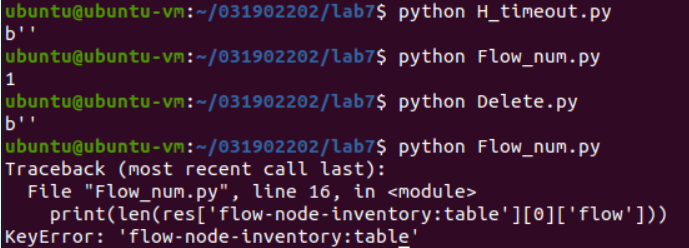
-
Ryu
(1) 编写Python程序,调用Ryu的北向接口,实现上述OpenDaylight实验拓扑上相同的硬超时流表下发。#!/usr/bin/python import requests from requests.auth import HTTPBasicAuth def http_post(url,jstr): url= url headers = {'Content-Type':'application/json'} resp = requests.post(url,jstr,headers=headers) return resp if __name__ == "__main__": url='http://127.0.0.1:8080/stats/flowentry/add' with open('ryu_htimeout.json') as f: jstr = f.read() resp = http_post(url,jstr) print (resp.content) { "dpid": 1, "cookie": 1, "cookie_mask": 1, "table_id": 0, "hard_timeout": 20, "priority": 65535, "flags": 1, "match":{ "in_port":1 }, "actions":[ { "type":"OUTPUT", "port": 2 } ] }

(2) 利用Mininet平台搭建下图所示网络拓扑,要求支持OpenFlow 1.3协议,主机名、交换机名以及端口对应正确。拓扑生成后需连接Ryu,且Ryu应能够提供REST API服务。
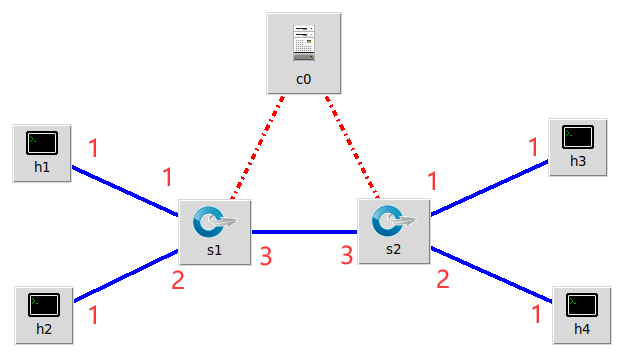


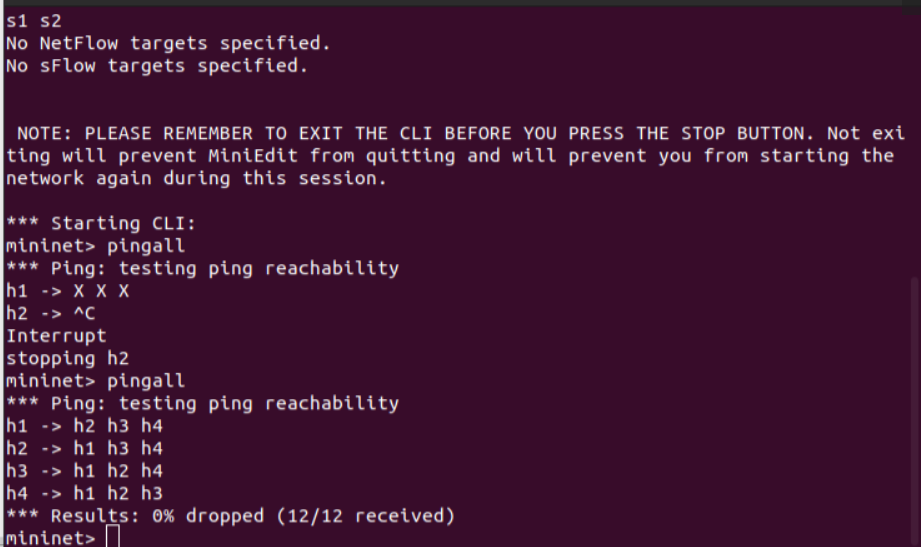
(3) 整理一个Shell脚本,参考Ryu REST API的文档,利用curl命令,实现和实验2相同的VLAN。
| VLAN_ID | Hosts |
|---|---|
| 0 | h1 h3 |
| 1 | h2 h4 |
curl -X POST -d '{
"dpid": 1,
"match": {
"in_port": 1
},
"actions": [
{
"type": "PUSH_VLAN",
"ethertype": 33024
},
{
"type": "SET_FIELD",
"field": "vlan_vid",
"value": 4096
},
{
"type":"OUTPUT",
"port": 3
}
],
"priority":5
}' http://localhost:8080/stats/flowentry/add
curl -X POST -d '
{
"dpid": 1,
"priority":5,
"match": {
"in_port": 2
},
"actions": [
{
"type": "PUSH_VLAN",
"ethertype": 33024
},
{
"type": "SET_FIELD",
"field": "vlan_vid",
"value": 4097
},
{
"type":"OUTPUT",
"port": 3
}
]
}' http://localhost:8080/stats/flowentry/add
curl -X POST -d '
{
"dpid": 1,
"match": {
"vlan_vid": 0
},
"actions": [
{
"type": "POP_VLAN",
"ethertype": 33024
},
{
"type":"OUTPUT",
"port": 1
}
],
"priority":5
}
' http://localhost:8080/stats/flowentry/add
curl -X POST -d'
{
"dpid": 1,
"match": {
"vlan_vid": 1
},
"actions": [
{
"type": "POP_VLAN",
"ethertype": 33024
},
{
"type":"OUTPUT",
"port": 2
}
],
"priority":5
}
' http://localhost:8080/stats/flowentry/add
curl -X POST -d '{
"dpid": 2,
"match": {
"in_port": 1
},
"actions": [
{
"type": "PUSH_VLAN",
"ethertype": 33024
},
{
"type": "SET_FIELD",
"field": "vlan_vid",
"value": 4096
},
{
"type":"OUTPUT",
"port": 3
}
],
"priority":5
}' http://localhost:8080/stats/flowentry/add
curl -X POST -d '
{
"dpid": 2,
"match": {
"in_port": 2
},
"actions": [
{
"type": "PUSH_VLAN",
"ethertype": 33024
},
{
"type": "SET_FIELD",
"field": "vlan_vid",
"value": 4097
},
{
"type":"OUTPUT",
"port": 3
}
],
"priority":5
}' http://localhost:8080/stats/flowentry/add
curl -X POST -d '
{
"dpid": 2,
"match": {
"vlan_vid": 0
},
"actions": [
{
"type": "POP_VLAN",
"ethertype": 33024
},
{
"type":"OUTPUT",
"port": 1
}
],
"priority":5
}
' http://localhost:8080/stats/flowentry/add
curl -X POST -d'
{
"dpid": 2,
"match": {
"vlan_vid": 1
},
"actions": [
{
"type": "POP_VLAN",
"ethertype": 33024
},
{
"type":"OUTPUT",
"port": 2
}
],
"priority":5
}' http://localhost:8080/stats/flowentry/add
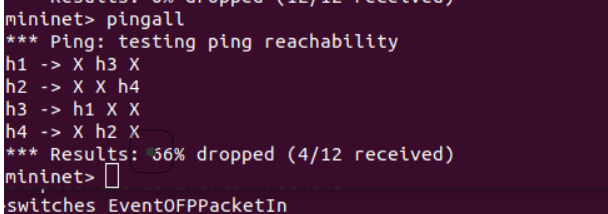
(二)进阶要求
编程实现基本要求第2部分Ryu(3)中的VLAN划分。
(三)实验报告
- 请用Markdown排版;
- 将所有本实验相关文件保存在目录/home/用户名/学号/lab7/中;
- (一)只需要提交实现相应Python代码和执行结果截图,其余文字请勿赘述;
- (二)不做必须要求,有完成的同学请提交Python代码和运行结果,文件保存目录参照要求2。
- 个人总结,包括但不限于实验难度、实验过程遇到的困难及解决办法,个人感想,不少于200字。
(四)心得体会
-
本次实验对我来说具有一定难度,实验期间遇到的第一个问题是运行上一次实验创建的 L2Switch.py 出现错误,报错“AttributeError: module 'ryu.ofproto.ofproto_v1_0' has no attribute 'OFPET_EXPERIMENTER'”,始终未找到最终原因。最后改用安装 Ryu 时自带的simple_switch_13.py,成功启动。
-
第二个问题是启动 simple_switch_13.py 时没有一起运行 ofctl_rest.py 开启控制器的北向接口,导致下发流表失败。
-
通过本次实验学习我了解了如何正确使用 python 向指定 url 发送请求来调用 REST API,学习
了相关 API 的使用。


